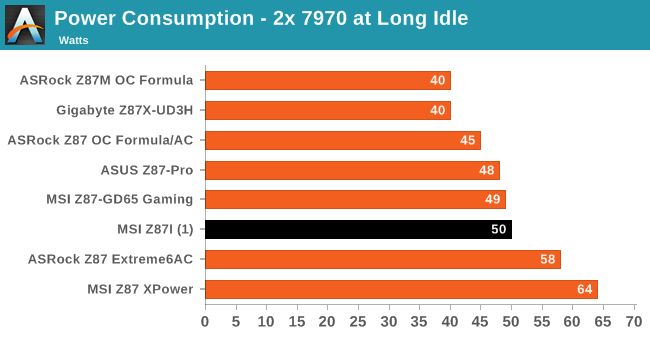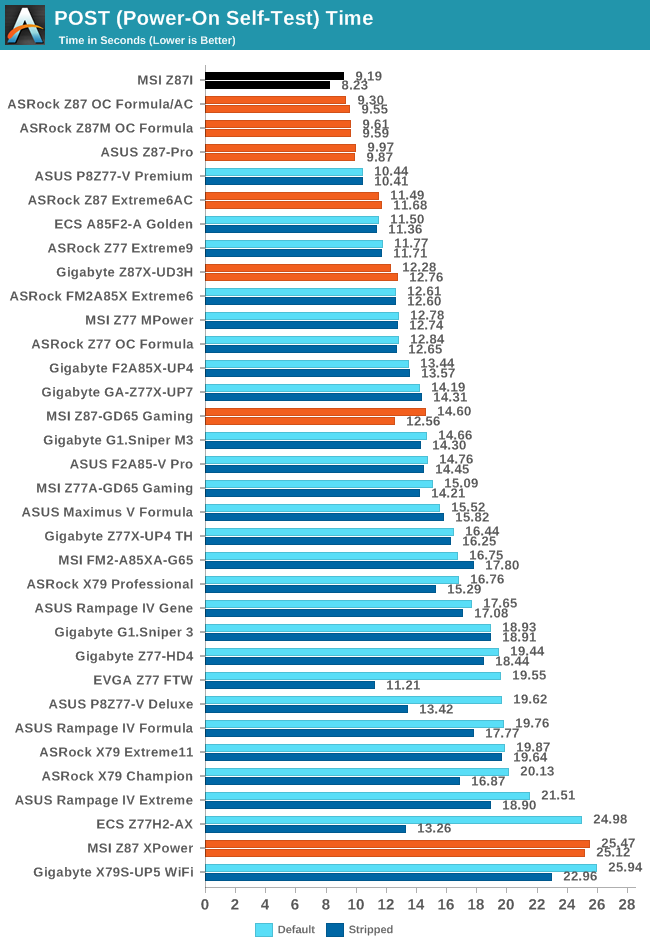MSI Z87I Review: Mini-ITX Haswell for $140
by Ian Cutress on August 27, 2013 10:15 AM EST- Posted in
- Motherboards
- MSI
- Mini ITX
- Z87
Many thanks to...
We must thank the following companies for kindly providing hardware for our test bed:
Thank you to OCZ for providing us with 1250W Gold Power Supplies.
Thank you to G.Skill for providing us with memory kits.
Thank you to Corsair for providing us with an AX1200i PSU, Corsair H80i CLC and 16GB 2400C10 memory.
Thank you to ASUS for providing us with the AMD GPUs and some IO Testing kit.
Thank you to ECS for providing us with the NVIDIA GPUs.
Thank you to Rosewill for providing us with the BlackHawk Ultra, and 1600W Hercules PSU for extreme dual CPU + quad GPU testing, and RK-9100 keyboards.
Thank you to ASRock for providing us with the 802.11ac wireless router for testing.
Test Setup
| Processor |
Intel Core i7-4770K Retail 4 Cores, 8 Threads, 3.5 GHz (3.9 GHz Turbo) |
| Motherboards |
ASRock Z87 Extreme6/AC ASRock Z87 OC Formula/AC ASRock Z87M OC Formula ASUS Z87-Pro Gigabyte Z87X-UD3H MSI Z87-GD65 Gaming MSI Z87 XPower MSI Z87I |
| Cooling |
Corsair H80i Thermalright TRUE Copper |
| Power Supply |
OCZ 1250W Gold ZX Series Corsair AX1200i Platinum PSU |
| Memory |
GSkill TridentX 4x4 GB DDR3-2400 10-12-12 Kit Corsair Vengeance Pro 2x8 GB DDR3 2400 10-12-12 Kit |
| Memory Settings | XMP (2400 10-12-12) |
| Video Cards |
ASUS HD7970 3GB ECS GTX 580 1536MB |
| Video Drivers |
Catalyst 13.1 NVIDIA Drivers 310.90 WHQL |
| Hard Drive | OCZ Vertex 3 256GB |
| Optical Drive | LG GH22NS50 |
| Case | Open Test Bed |
| Operating System | Windows 7 64-bit |
| USB 2/3 Testing | OCZ Vertex 3 240GB with SATA->USB Adaptor |
| WiFi Testing | D-Link DIR-865L 802.11ac Dual Band Router |
Power Consumption
Power consumption was tested on the system as a whole with a wall meter connected to the OCZ 1250W power supply, while in a dual 7970 GPU configuration. This power supply is Gold rated, and as I am in the UK on a 230-240 V supply, leads to ~75% efficiency > 50W, and 90%+ efficiency at 250W, which is suitable for both idle and multi-GPU loading. This method of power reading allows us to compare the power management of the UEFI and the board to supply components with power under load, and includes typical PSU losses due to efficiency. These are the real world values that consumers may expect from a typical system (minus the monitor) using this motherboard.
While this method for power measurement may not be ideal, and you feel these numbers are not representative due to the high wattage power supply being used (we use the same PSU to remain consistent over a series of reviews, and the fact that some boards on our test bed get tested with three or four high powered GPUs), the important point to take away is the relationship between the numbers. These boards are all under the same conditions, and thus the differences between them should be easy to spot.

While at the low end of our PSU efficiency, the readings for the Z87I at long idle are higher than expected compared to full sized ATX motherboards. At normal idle however, the MSI is efficient – similarly during CPU loading. As the Z87I is a mini-ITX motherboard, we can only test with one GPU installed, explaning the difference in results for a gaming load.
Windows 7 POST Time
Different motherboards have different POST sequences before an operating system is initialized. A lot of this is dependent on the board itself, and POST boot time is determined by the controllers on board (and the sequence of how those extras are organized). As part of our testing, we are now going to look at the POST Boot Time - this is the time from pressing the ON button on the computer to when Windows 7 starts loading. (We discount Windows loading as it is highly variable given Windows specific features.) These results are subject to human error, so please allow +/- 1 second in these results.

I am glad to see another motherboard POST less than 10 seconds in our test, although mini-ITX motherboards have the advantage in this test by only dealing with one discrete GPU compared to two used in other motherboards).










46 Comments
View All Comments
Schmov17 - Tuesday, August 27, 2013 - link
Do the dual NICs support teaming?bobbozzo - Tuesday, August 27, 2013 - link
If you want gbps or higher performance, you shouldn't be using Realtek NICs; it's almost impossible to get full gbps speed out of them.Intel, Broadcom, and possibly Qualcomm Atheros are currently the best choices, and the server-model NICs have more virtualization / offloading capabilities than the standard embedded or desktop models.
TheButton - Tuesday, August 27, 2013 - link
I know beggars can't be choosers but I'd love to see a review of the B75(IvyBridge) or B85 (Haswell) mITX motherboards. They are cheap (can be had for <$100) and seem to have all the right features, USB3.0, PCI-E 3.0x16, SATA 6Gbps, 2 Dimm slots. I know they are marketed for small business but they seem ideal for small form-factor gaming machines and I'd love to see how B85 compares versus H81 and/or Z87 especially in the mITX form factor.Can we expect any such reviews to be forthcoming Ian?
DMisner - Tuesday, August 27, 2013 - link
Just curious if under 'Visual Inspection' you could add a picture of the back of the motherboard. I know sometimes motherboard manufacturers place some small parts on the back and often they get in the way of aftermarket cooler back-plates (especially on m-ITX motherboards) which can be a frustrating surprise to find upon delivery.Razorbak86 - Tuesday, August 27, 2013 - link
For this particular motherboard, check Newegg product #4 (out of 5).Razorbak86 - Tuesday, August 27, 2013 - link
... Newegg product photo #4 (out of 5)Ammaross - Tuesday, August 27, 2013 - link
"ALC892 audio solution which performed average in our audio tests. If MSI were aiming more at a HTPC or gaming market, we might have seen an ALC898"Wouldn't most gamers be utilizing a USB-audio headset?
DanNeely - Tuesday, August 27, 2013 - link
One of the reasons I wouldn't want to ever share an apartment is that I can game on speakers; and no one can tell me otherwise.LordHaHa - Tuesday, August 27, 2013 - link
Was there any investigation into undervolting the system? The OC results are positive, but I'd rather use mATX+ for higher performance purposes. On the other hand, I could think of some applications for a low-footprint, low-power, no-to-little-default-performance-sacrifice mITX system.londiste - Wednesday, August 28, 2013 - link
that's what i think when i see any mitx review...additionally, why not give power consumption a go with 35/45w tdp cpu and minimal needed hardware attached. for example 4670t, 1 stick of ram and 1 hdd/ssd, omitting a dedicated gpu entirely? i have several mitx boxes running off picopsu (or similar prebuilt solutions from case manufacturers).